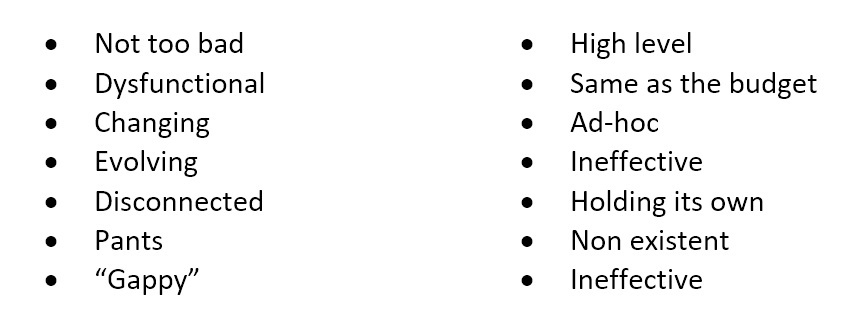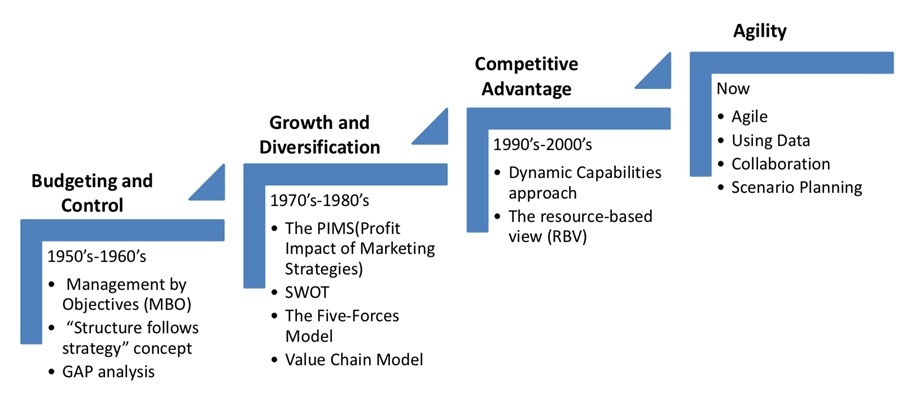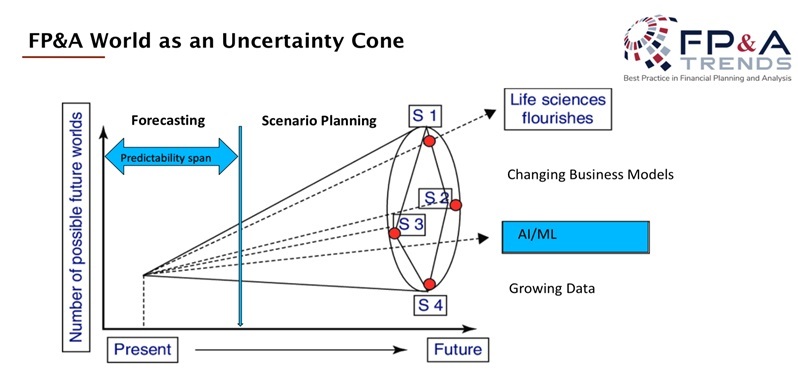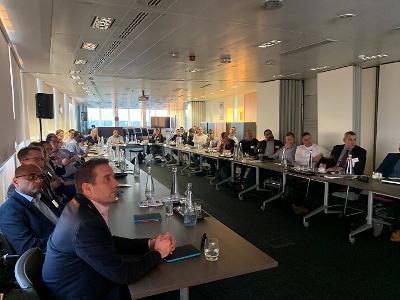 These notes were made during the meeting of the FP&A Board on 16th May 2019 in London. They are a mixture of comments made by attendees and thoughts of those who presented case studies.
These notes were made during the meeting of the FP&A Board on 16th May 2019 in London. They are a mixture of comments made by attendees and thoughts of those who presented case studies.
These notes are the copyright of FP&A Board. They are not to be used in publications unless authorized by the FP&A Board.
The Board met to explore the evolution of Long-Range and Strategic Planning and to discuss the role FP&A should take.
Group Discussion: What are the keywords that describe your planning process:
From the above it was apparent that most organisations struggle with both. The aim of the board meeting was to share ways in which this can be enhanced.
Evolution of Planning
What are the differences?
- Long Range Plan is an extension of the one-year planning exercise to three –five years and more. It is simply a prediction of future revenues and expenses based on past events. A long-range plan assumes a stable future market and is numbers-driven.
- Strategic planning is much more complex and crucial to the ongoing success of an organisation. A good strategic plan will ensure that an organisation is quick to respond to a changing environment. This plan guides achievement of goals, missions and vision of the organisation in more details.
Group Discussion: What prevents effective planning?
- Disruption in the environment (e.g. BREXIT)
- Technology/data availability
- Unpredictability/uncertainty
- Resources
- Time
- Collaboration/communication
- Gaming
- Too many scenarios to run
- Disconnect between the Board and the Business
The Evolution of Strategic Planning
Today’s business environment greatly reduces the predictability span that was achievable in years gone by. For today’s environment, scenario planning becomes more important as was of trying to understand and predict what may happen in the future.
Above graphic adapted from Uncertainty Cone to Bound the Future by Paul Schoemaker
The Evolving Role of FP&A in Strategic and Long Range Planning
The FP&A function is very well positioned to coordinate (co-pilot) and enhance the strategic planning process.
- They possess the skills
- Have access to the data and technology to provide analytics to implement successful strategic plans in a time of uncertainty.
- Delivering excellent timely, accurate and reliable decision support information to managers and executives is the essence of FP&A
- Play Scenarios and test assumptions
- FP&A role would be in putting together the figures, analysing the possible financial consequences, insuring overall coherences of the figures, etc...
- Managing or enhancing the process with analytical insights and foresight through modelling and scenario planning.
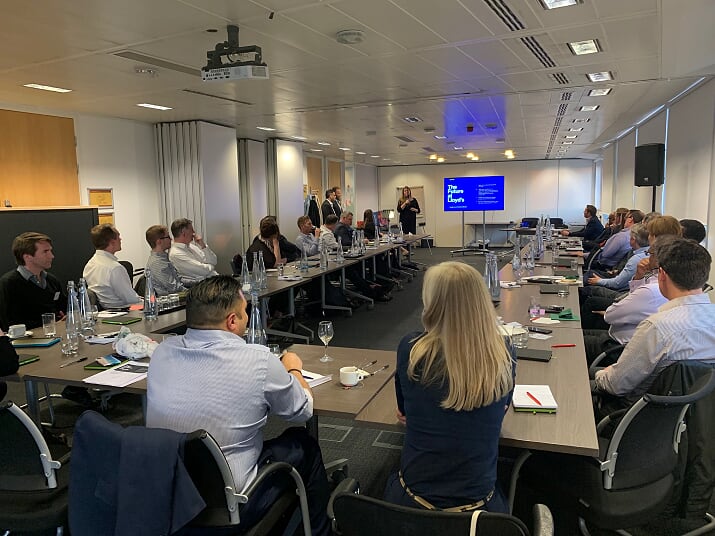
The FP&A function is very well positioned to lead the strategic planning execution process
- According to a Fortune magazine, nine out of ten organizations fail to implement their strategic plan for many reasons: 60% of organizations don’t link strategy to budget
75% of organizations don’t link employee incentives to strategy
86% of business owners and managers spend less than one hour per month discussing strategy
- 95% of a typical workforce doesn’t understand their organization’s strategy
- The strategic plan addresses the what and why of business actions, whereas implementation addresses who, where, when, and how.
- Strategy implementation is the process that turns strategies and plans into actions to achieve both a vision of the future and associated financial and non-financial goals (like customer satisfaction).
- Implementing your strategic plan is as important, or even more important, than creating your strategy.
Strategy Execution Steps
- Align strategic financial long term/medium/short term plans (budget)
- Build all department annual plans around the strategic plan
- Produce specific versions of the plan for each business unit or service
- Establish a system of scorecards for tracking and monitoring performance to plans
- Establish and align performance management and reward system
- Establish reporting to monitor progress/performance
- Set up frequent strategy implementation status meetings and
- Set up financial simulation modeling, forecast updates, and what-if analysis
- Set up annual strategic review dates
- Create a long-term calendar plan
Group Discussions:
What systems capabilities are required for the effective Strategic Planning Processes?
- Master Data Definitions
- Relevant Dashboards, reports that are tailored (and they can adjust) to individual users
- Ability to set targets ‘on demand’ and let the system work out the detail behind the target
- Must be intuitive to users – good front-end
- Flexible platform
- Agree key drivers
- Transparency of data
- Iterative models
- Intelligent workflow that tells users what they need to do and when
- Sandbox – ability to develop scenarios whose changes/results can be rolled back
- Must be robust and fast
- Visualisation of data
- Model recovery
- Rules flexibility
- Access rights
- Integration with other data sources
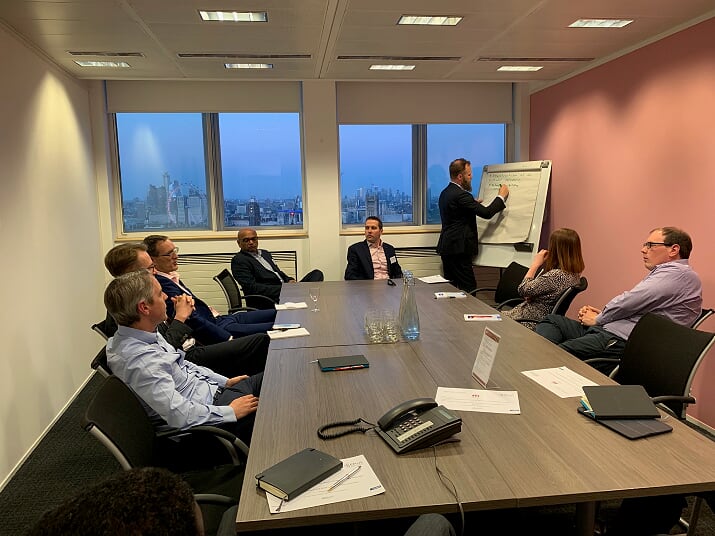
What management approach should FP&A adopt in strategic Planning Process?
- Act as facilitator
- Challenge plans and assumptions
- Design the process
- Run the process
- Ensure accountability
- Test the assumptions
- Talk about the ‘elephant in the room’
- Be mindful of regulations
- Ensure collaboration
- Contribute knowledge to the plans
About the FP&A Board
The mission of the International FP&A Board is to guide the development and promotion of better practices in global FP&A, identify and support new trends, skillsets and innovations. For more information on the board and to view our other events, visit www.fpa-trends.com/fpa-board
Our Sponsors
We are very grateful to our global sponsors and partners Anaplan, IWG and Michael Page for their great support.


